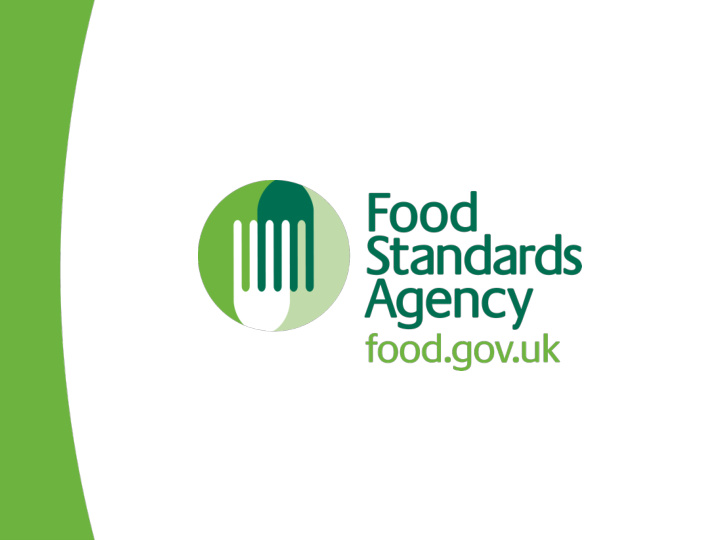



NACC South West Region Spring Seminar 19 March 2015 Tracey Smith Foodborne Disease Control FSA Foodborne Disease Strategy • Campylobacter Risk Management Programme • Listeria Risk Management Programme • Other pathogens
Acting on Campylobacter Together (ACT) Campaign • Tackling Campylobacter is FSA top priority in the fight against food poisoning. • The most significant source of Campylobacter with respect to human health is raw poultry meat - 70% campylobacteriosis cases can be attributed to chicken. • ACT campaign brings together work from farm to fork, including chicken producers, processors, caterers and retailers.
ACT – Farm to Fork On – farm Processing European Retail
Retail Retail survey • 4000 samples at point of sale, UK- wide • 12 months from Feb 2014 • Publish results every 3 months Retail consumer communications • Labelling ‘Do not wash' on fresh poultry: consistent, prominent, readable
Consumers • Don’t wash raw chicken. • Washing raw chicken can spread Campylobacter by splashing contaminated water to other surfaces.
Food business Raise awareness of Campylobacter • Raise awareness of Campylobacte r improved risk management through better handling, thorough cooking and good kitchen hygiene practices. • Include Campylobacter messaging in training materials e.g. for EHOs, food hygiene trainers, FBOs, food handlers, catering students.
Campylobacter - What next? • ACT e-newsletter published: http://www.food.gov.uk/news- updates/campaigns/campylobacter/actnow/ act-e-newsletter • Publication of Q4 Retail Survey Results • Food Safety Week 2015 The Chicken Challenge 18 – 24 May
Listeria Risk Management Programme Consumer behaviour Procurement / provision of food to high risk groups Industry compliance and enforcement
What is listeriosis? • Infection caused by Listeria monocytogenes is rare but is the number one cause of death due to foodborne disease in the UK. • Most cases are hospitalised and approximately a third die. • Generally associated with ready-to-eat foods - 73% of listeriosis outbreaks (2003-2012) were associated with hospital sandwiches.
Why is Listeria monocytogenes a problem? • Widely distributed in the environment. • Organism is adaptable and persistent. • Grows at refrigerated temperatures. • Prolonged incubation (up to 90 days). • Salt tolerant and can grow at low pH levels.
Higher risk foods • Higher risk foods for L. monocytogenes are generally those that are: – Ready-to-eat – Able to support the growth of the bacterium – Sold with a long shelf life – Chilled, i.e. refrigerated
High-risk population groups Listeriosis generally affects those with reduced immunity: – Pregnant women and their unborn babies – Newborns – Weakened immunity – Patients with specific underlying medical conditions and/or undergoing certain drug treatments – Elderly (People aged over 60 years)
Number of cases >60 1990-2014 (PHE)
Consumer behaviours / actions PRIORITY FOCUS: Cancer patients
Industry compliance / enforcement PRIORITY FOCUS: SMEs producing high-risk chilled RTE foods
Procurement / provision of food to the vulnerable PRIORITY FOCUS: Hospitals
Listeria guidance for hospitals and healthcare organisations • Guidance aims to help healthcare organisations reduce the risk of vulnerable groups contracting Listeriosis and highlight important controls for L. monocytogenes. Guidance includes information on: – Control of growth – Control of contamination – Management controls – Methods of supplier assessment – Advice for sampling plans
Listeria controls Effective chilling Personnal hygiene, Effective Effective cleaning particularly management and disinfection handwashing, controls and procedures and handling training practices Cross- contamination control Separation between raw and ready-to-eat foods
Further information • Listeria Risk Management Programme: http://www.food.gov.uk/science/microbiology/listeria • Public Health England: Surveillance reports: https://www.gov.uk/government/publications/listeria- monocytogenes-surveillance-reports • Campylobacter : http://www.food.gov.uk/policy- advice/microbiology/campylobacterevidenceprogramme/ • E.coli O157: Control of cross-contamination refreshed guidance: http://www.food.gov.uk/news- updates/news/2014/6106/ecoli
Any questions? tracey.smith@foodstandards.gsi.gov.uk
Recommend
More recommend